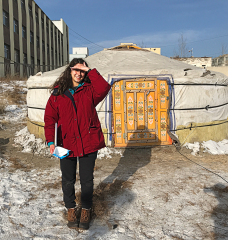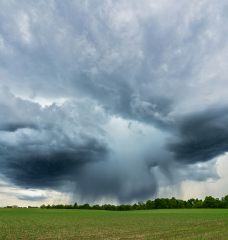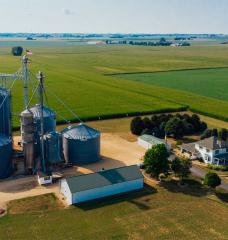Description
The way we grow and distribute food today is deeply dependent on fossil fuels, yet that dependence can feel invisible. Sustainable food systems researcher Prof. Jennifer Clapp joins the show to walk us through all the ways fossil fuels are used to produce one simple food item: a tortilla chip. Along the way, we’ll explore the hard work being done to eliminate climate pollution from the food we eat.
Prof. Jennifer Clapp is a Tier I Canada Research Chair in Global Food Security and Sustainability and Professor in the School of Environment, Resources and Sustainability at the University of Waterloo, Canada. Her research focuses on global governance at the intersection of the economy, food security and food systems, and the natural environment. Dr. Clapp is a member of the International Panel of Experts on Sustainable Food Systems (IPES-Food) and a member of the Scientific Advisory Committee of the UN Food Systems Coordination Hub.
This episode was produced in collaboration with TABLE, an international coalition of universities that helps the public understand our food system. Their podcast mini-series Fuel to Fork, produced with IPES-Food and the Global Alliance for the Future of Food, expands on the topic of this episode to explore fossil fuel use across the global food system.
For more episodes of TILclimate by the MIT Climate Project, visit tilclimate.mit.edu. Subscribe to receive notifications about new episodes and follow us on LinkedIn. Ask us your climate question at climate.mit.edu/ask.
Credits
Laur Hesse Fisher, Host and Senior Editor
Aaron Krol, Writer and Executive Producer
David Lishansky, Editor and Producer
Grace Sawin, Student Production Assistant
Michelle Harris, Fact Checker
Music by Blue Dot Sessions
Artwork by Aaron Krol
Transcript
LHF: Hello, and welcome to Today I Learned: Climate from the Massachusetts Institute of Technology. I’m Laur Hesse Fisher.
If you’re like many of our listeners, you might be wondering: okay, so the CO2 from burning fossil fuels is warming the planet, right? So why haven’t we just gotten rid of all these fossil fuels already?
Because we live in a world that’s currently dependent on fossil fuels, yet a lot of that dependence is invisible to us. So we collaborated with TABLE, an international coalition of universities that helps the public understand our food system. Their recent podcast miniseries is called Fuel to Fork, and it explores all the many ways that fossil fuels are involved in putting food on our plates.
And today, we’re going to get a glimpse into the hard work that is happening to eliminate pollution from the food system—and in doing so, explore the very real ways that our food now depends on fossil fuels.
Even to produce the simplest thing, like a tortilla chip.
JC: I love tortilla chips. In fact, I had some on the weekend, and they were very tasty.
LHF: That’s Jennifer Clapp.
JC: I'm a professor and Canada research chair in global food security and sustainability at the University of Waterloo in Canada. I'm also a member of IPES-Food, which is the international panel of experts on sustainable food systems.
LHF: She’s here to help us follow the journey of a tortilla chip from farm to grocery store, taking note of all the ways fossil fuels are used along the way. So let’s get started.
JP: Well, tortilla chips have relatively few ingredients. They're made of corn, or in the rest of the world, it's called maize.
LHF: Here in the U.S., we have over 90 million acres of cornfields. If that were a state, it would be the fifth largest, just barely behind Montana. And if you took a drive through this great state of corn, the first thing you might notice above the vast, waving expanses of green are the machines that tend the corn from planting to harvest.
JP: Farm machinery typically runs on Diesel fuel. And that's the machinery used to plow the fields, drill the seeds, spread the fertilizer, spread the pesticides, spread the herbicides. Also for harvesting crops, big machinery is used, you know, combine harvesters and other kinds of machines that thresh the grain.
LHF: It’s probably no surprise that these great machines need fuel to run. But what about the quieter parts of a corn farm—like the barns?
JC: Corn has a lot of moisture in it. It's a heavy crop, and to store it properly it needs to be dried. And farmers typically use giant fans in a barn to dry out the corn and typically heat those barns with propane fuel.
LHF: The two things we’ve mentioned so far—the farming machinery, and drying the crop—make up about half of the fossil energy use on a typical corn farm. There’s one last big chunk of emissions that we’re going to come back to a little bit later in this episode.
For now, though, we’re packing up our corn for sale.
JC: Commodities like corn do travel around a fair bit. If it's trucked, it's typically using diesel fuel. And also, if it's shipped, it's definitely using oil.
LHF: Those fossil fuels get our dried corn to a factory, where it will be turned into masa, the delicious dough that makes a tortilla.
JC: And what it involves is soaking and simmering, like cooking, these dried kernels of corn for up to 12 hours. And that process is called wet milling.
LHF: For our tortilla chips, this is almost the end of the line: the masa from the wet mill is ready to be shaped, baked and fried. Other corn products will keep passing through more screens and grinders and dryers and fermenters, on their way to becoming things like cornstarch, and corn syrup, and even the ethanol we add to gasoline.
There isn’t good recent data on this, but back in 2001 the US Energy Information Administration did a study of corn wet mills and found that they used 15% of all the energy in, not just corn, but the entire U.S. food industry.
JC: So that gives you a sense of just how energy consumptive it is.
LHF: When you hear about “ultra-processed” foods, this is what it means: the ingredients go through a whole bunch of machines to break them down to their proteins and fibers and oils and such. And it tends to use a lot of fossil fuels—and be less healthy for us, too.
With our tortilla chips, the last machine would be the fryer that makes them nice and crispy and snackable. But there’s one more step before they’re shipped to the grocery store, and that’s packaging.
JC: In my local community I can buy corn chips that come in a paper bag, which really makes me happy. But most corn chips that you're going to find in a grocery store shelf are packaged in plastic.
LHF: And that plastic is made of—do you know? It’s oil!
Yeah, our food system doesn’t rely on fossil fuels just for energy. Tons of stuff—packaging, farm equipment—is also made of fossil fuels.
JC: You might have seen large sheets of plastic covering farm fields that sort of keep in moisture and keep temperatures warm in the soil, or covering a greenhouse, Herbicides, pesticides; they're all fossil fuel sort of oil based chemicals. So when we think about fossil fuels on the farm, they're just, they’re everywhere.
LHF: Remember earlier, when we found that the farming and drying machinery added up to about half of a farm’s fossil energy use? Well, most of the remaining half comes from just one of those fossil fuel-based chemicals alone.
JC: The fertilizer use is probably the biggest use of fossil energy when we're talking about growing corn.
LHF: For as long as there’s been farming, people have been adding fertilizers like manure and wood ash to soil to revitalize it.
JC: These products really started to be used much more frequently after around the 1840s, when scientific developments led to an understanding about the importance of nitrogen, phosphorus, and potassium as key nutrients that plants need for better plant growth.
Phosphorus and potash are actually today typically mined from the earth and processed to make fertilizers.
LHF: But the third nutrient, nitrogen, is trickier: there’s no nitrogen rock that we can mine. On the other hand, there is one very abundant source of nitrogen very close to hand. It’s in the air we’re breathing. Earth’s atmosphere is almost 80% nitrogen gas.
JC: And scientists knew that nitrogen was in the air. They just didn't know how to capture it and make it into a physical, usable form that could be applied to soil.
LHF: And then, in the early 1900s, two German chemists, Fritz Haber and Carl Bosch, figured it out. If you react nitrogen with hydrogen, they mix to make NH3, also known as ammonia. And this became the main ingredient for modern fertilizers.
The catch is that the hydrogen comes from yet another fossil fuel: natural gas.
JC: So the Haber Bosch process really changed everything because people didn't have to worry about where the nitrogen was going to come from to fertilize crops. And the use of synthetic nitrogen increased massively.And what that's meant is that more crops can be grown. More land around the world can be cultivated for agriculture, because the nutrients can be continually replenished.
LHF: And on that land, humans are supplying a regular stream of nitrogen, provided mostly by natural gas. Where, unfortunately, it continues to impact the climate in yet another way.
JC: There's been a tendency to over-apply fertilizer. Just as kind of like an insurance policy that farmers want to be sure that they're putting enough on the field to ensure plant growth.
But not all nitrogen that's put down in the field is taken up by the plant. And then soil microbes eat up the nitrogen, and it converts it into a gas called nitrous oxide, which is more damaging than carbon dioxide when we're talking about climate change. And corn uses a lot of fertilizer, so it has a lot of nitrous oxide emissions.
LHF: Fertilizer is by far the biggest way that humans create nitrous oxide, this highly climate-warming gas. If you add both the manufacturing process and the nitrous oxide, fertilizer has the same impact on the climate as a major country—in fact, it contributes as much to climate change each year as Japan does, which is the world’s seventh-largest climate polluter.
JC: So all in all, the fertilizer industry is pretty significant.
LHF: Okay, so what do we do about all this? You might ask: is it even possible to have our tortilla chips without the climate pollution?
JC: Can I imagine a fossil fuel free bag of corn chips? I think, in this current world that we live in, that's a bit hard to imagine, given all of the places in the whole production process that have relied on and continue to rely on fossil energy.
LHF: Let’s take farming machinery for a moment. You might say, well, couldn’t we just run these machines on electricity, like switching a gas-powered car for an electric car? And, yeah—we probably could.
JC: But it's not straightforward. Because a tractor has to have a lot of horsepower, especially for plowing, especially for these sort of harvesting and threshing activities.
LHF: That means that an electric tractor would need to hold a lot of energy in its battery. For the heaviest equipment like combine harvesters, the industry is still waiting on more powerful motors and batteries to hit the market—and to be affordable.
But don’t throw up your hands. There is a lot we can do right now. Like in the drying barns, which can be heated electrically, and the wet mills that can switch to clean power sources. Or what about the problem of overapplying nitrogen? That’s no good for anybody who cares about our climate—but it’s also especially bad for the people buying all this fertilizer that just ends up being wasted.
JC: Because it's a big cost for farmers. And the big companies are all investing in digital technology that can analyze the type of soil and its fertility, and then provide advice to farmers that says you should only put this much fertilizer in this part of your field. Maybe you want to use a little bit more in that part of your field.
LHF: There are also these things called “slow release” fertilizers, which are coated in a slow-dissolving plastic so all the nitrogen doesn’t get dumped on the field at once. Or, could we produce the nitrogen our corn needs without using natural gas? There are emerging processes that use clean electricity instead, or even engineered microbes in the soil. All of these ideas are being actively pursued right now—and also studied to see what kinds of unintended effects might arise if we start doing things like treating our soils with plastics, or using a lot of energy for AI-powered digital farming tools.
So today, we wanted to highlight the often hidden fossil fuel use in our food system—but we also wanted to highlight the often-invisible solutions that are happening. Because as more and more of us get activated and equipped to tackle this issue, researchers, innovators, investors, and folks working across the food system get creative, and solutions like these become possible.
JC: So it's a big ask to say, okay, throw that model out the window and start scratch with something else. But there are models of other things that can work, such as agroecology, which is using nature's own processes to provide the fertilization of soils by growing different crops next to each other. It's a big change. And so it's not going to happen overnight. But I always think about the fact that the way that we ended up with the agriculture we have today took about 200 years. Farmers did adopt synthetic fertilizers. They did adopt hybrid seeds. You know all of the aspects that we think of as conventional farming today were at one point new technologies. So we shouldn't think necessarily that farmers are going to be resistant to change. But that change has to be tangible for them in terms of the benefits, and it has to be easy, and it has to be affordable.
LHF: And that’s harder than just saying, keep the fossil fuels in the ground. But in the end, this hard, steady work is what it’s going to take to have a clean economy that offers us a good living and the things that we need.
And even the things that we like, like a bag of chips.
That is our show. But if you’re interested in learning more about fossil fuels in the food system, I invite you to check out the entire Fuel to Fork miniseries from TABLE, in collaboration with IPES-Food and the Global Alliance for the Future of Food. Just look up Fuel to Fork on Apple Podcasts, Spotify, or wherever you get your podcasts.
And hey, you can also look up TILclimate there and follow us—there are lots more episodes to brush up on your climate knowledge. Or get in touch and ask us your climate change questions! Email us at tilclimate@mit.edu, or leave us a voicemail at 617 253 3566.
TILclimate is the climate change podcast of the Massachusetts Institute of Technology. Aaron Krol is our Writer and Executive Producer. David Lishansky is our Audio Producer. Michelle Harris is our fact-checker. Grace Sawin is our Student Production Assistant. The music is by Blue Dot Sessions. And I’m your Host and Senior Editor, Laur Hesse Fisher.
A big thanks to Prof. Jennifer Clapp for speaking with us, and to you, our listeners. Keep up your climate curiosity.
Dive Deeper
- Read more about Prof. Clapp.
- For a deeper dive into where fossil fuels are used in the global food system, check out the Fuel to Fork podcast mini-series produced by TABLE, IPES-Food and the Global Alliance for the Future of Food.
- For detailed data on the sources of greenhouse gas emissions in the global food system, see this scientific publication from the Food and Agriculture Organization of the United Nations. The data is also summarized in this report, and made available in an interactive tool where you can break down emissions by source, country, and type of greenhouse gas.
- Learn more about how fertilizer is produced and why it contributes to climate change with this Explainer from the MIT Climate Portal.
- This episode breaks down the use of fossil energy on a typical corn farm. You can find data on this question from the University of Minnesota and Iowa State University.
- TILclimate has covered topics relevant to today’s question in our episodes on farming a warmer planet and what I eat.
- For an overview of climate change, check out our climate primer: Climate Science and Climate Risk (by Prof. Kerry Emanuel).
- For more episodes of TILclimate by the MIT Climate Project, visit tilclimate.mit.edu.
We fact-check our episodes. Click here to download our list of sources.






